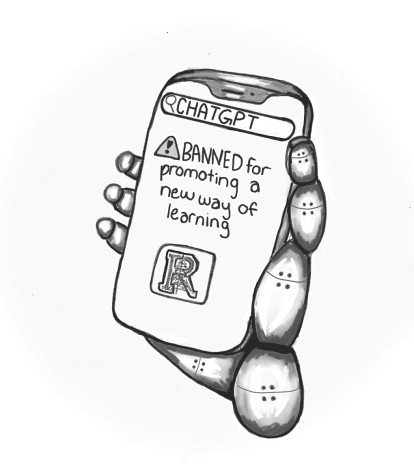The new tr(AI)lblazing technology: Artificial intelligence is changing the way education is taught
March 27, 2023
As the fall semester of my junior year came to a wrap, filled with stressful assignments, I started to hear the buzz of artificial intelligence (AI) technology being used in and outside of the classroom. Of course, I was aware of this mainstream issue of AI in the classroom, but I never realized its greater potential to optimize student learning.
Recently, there has been a growing trend of using AI in educational institutions, with ChatGPT being the most widespread. According to its founding company OpenAI, ChatGPT uses deep learning techniques to generate human-like, conversational responses to a prompt. Companies like International Business Machines, Meta and Salesforce have been using this technology to create quizzes and articles, while in contrast, almost all educational institutes have prohibited the use. This poses the question of whether or not to ban AI in schools, as there is no way to monitor it; I believe schools should embrace this technology as a new form of teaching and learning.
As an artist, I discovered DALL-E, which generates digital images based on prompts users’ input to the technology. I was astonished that AI could construct artwork with such specificity. In my Advanced Placement Painting and Drawing class, continuously coming up with original illustration concepts can be a challenging and time-consuming task. However, DALL-E offered me a great way to generate complex and detailed visuals of what a painting could look like. Trying to find references for a painting is a long process, since all paintings have to be original; with DALL-E, I am able to come up with prompts to help me paint with an individualized and unique image.
By using these programs, I can push the boundaries of my artistic works and explore new possibilities for design. This AI program has now become an essential part of my creative process and has broadened my perspective on the application of AI.
AI is not only a tool used in school; it is also interwoven into all technology, whether we know it or not. Through voice assistants like Apple’s Siri and Amazon’s Alexa or even image recognition programs such as Face ID, AI aids many people.
AI’s use in school is an ever-evolving battle. Professor Alex Lawrence at Weber State University in Utah has declared an educational emergency since the rise of AI, calling it “the greatest cheating tool ever invented.”
With access to powerful machine learning algorithms and online resources, some students may be tempted to use AI to complete assignments or even take tests. Educational institutions are deeply concerned AI will undermine the learning aspect of the school system, raising ethical concerns about academic integrity and fairness and whether students are actually learning. However, if teachers were to advise students on how AI can be incorporated into learning, cheating can be avoided. It’s likely a losing educational battle to try to prevent the use of AI given its pervasiveness.
 Cherie Shields, a high school English teacher in Oregon, told the New York Times that she uses AI in her classroom as a tool to teach. She used the technology to create outlines for their essays comparing and contrasting two stories on themes of gender and mental health. When the outlines were generated, the students put away their laptops and wrote handwritten essays.
Cherie Shields, a high school English teacher in Oregon, told the New York Times that she uses AI in her classroom as a tool to teach. She used the technology to create outlines for their essays comparing and contrasting two stories on themes of gender and mental health. When the outlines were generated, the students put away their laptops and wrote handwritten essays.
This is just one of the many ways educators can incorporate AI. Despite its initial intimidation, this technology presents a significant opportunity for teachers to integrate its beneficial advancements into the curriculum, thus helping to create a more personalized and dynamic educational experience that prepares students for the future.
The future is AI. As students enter the workforce, they will need to work with technology; therefore, teachers must learn to teach with it. A report from Grand View Research projects says that the AI market will increase at an annual growth rate of 46.2 percent by the year 2025, which makes AI one of the largest growing sectors in the economy.
The reality of the situation is that AI is not a passing fad, but rather an increasingly integral part of life, and therefore of the educational system. Educators must embrace this reality and develop a strategy to integrate AI effectively. The current response used to try to eliminate AI’s cheating capabilities on assignments is long-term, and there is a greater potential to this tool than meets the eye.
Instead of trying to eliminate the already accessible AI being used in academics, educators can learn to understand the technology and broaden their assignments. Teachers and educators need to learn to work with it and understand the technology. Society is in a constant state of evolution. While it can be a challenge adjusting to new circumstances like AI, it teaches us about new technology in this ever-changing world.























